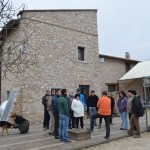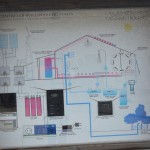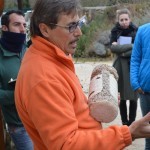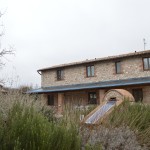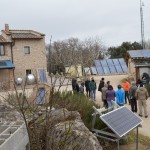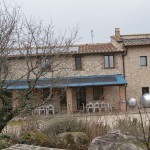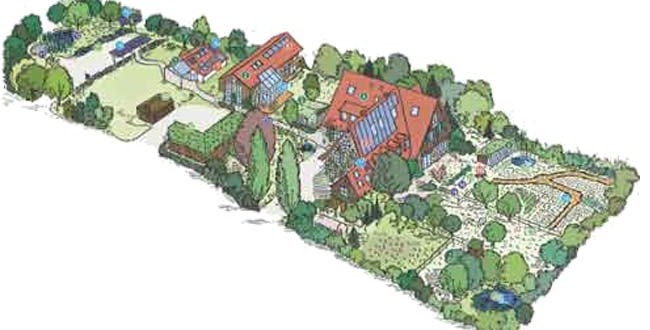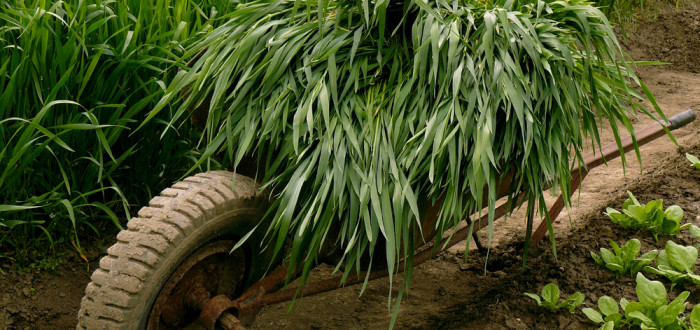PER – Park for Renewable Energy
PER is the result of a couple’s desire to put into practice the huge amount of theories that they had been studying over years and to realise a common dream. So together Alessandro and Chiara found a beautiful farmhouse in the Umbrian countryside, some friends who followed them and the willing to start a new life.
“The challenge was to start again the cultivation in the fields and solve the problems of water shortage.”
They started by planting many fruit trees of ancient varieties and by practicing organic farming since the beginning. They tried to cultivate tomatoes through dry farming, that is to say no longer watering them after they acclimatised. Beside a conventional vegetable garden, they also made beds for the synergistic garden and all around the main building there are spaces for developing permaculture projects. The farm products provide food for the people who live in the ecovillage and for the restaurant used when courses or events are hold at PER.
They have been producing preserves, jams, and dried products thanks to:
– Passive solar greenhouses
– Solar pumps for the irrigation of the fields
– Solar ovens
– Solar electric fences for keeping away wild animals (foxes, boars, stone martens, porcupines, badgers and deer) without hurting them.
They are constantly testing alternative methods of farming aiming to employ a reduced amount of water and agricultural machineries that contribute in polluting the environment too.
They also cultivate a particular type of broad bean called “Fava cottora di Collicelli e Frattuccia”, a species protected by the Slow Food Presidia Project.
But there’s more: they have transformed a ruin in a “NaturalHotel” with low environmental impact by using cutting-edge strategies.
Here’s some examples:
– Building materials with high thermal insulation. Inside the traditional stone wall, rebuild with the original stones of the collapsed building, cement-bonded wood fibre blocks have been placed in order to create the supporting structure. Thermal bridges with the outside have been eliminated, the roof has a 12-cm-high insulating layer and the whole building is heated through a floor heating system.
– Reuse of rainwater and optimisation of water consumption. Greywater is collected to be reused in the drains and, after having been treated in a constructed wetland, it is used for watering the garden. You will see the result of this system in every restroom of the building whenever you will wash yourself or flush the toilet with very little water but without changing neither the level of comfort nor your habits. Actually rainwater improves our hygiene because it’s a good alley for our skin and you’ll need half of the regular quantity of soap in order to wash yourself.
– Solar heating. Solar thermal collectors on the roof and on the ground produce hot water for bathrooms and partly for the heating system, while solar panels with thin film for the production of electricity are integrated in the structure of the building. In the small tower of the building there is the unit for warm air production. The two wind generators use the local breeze which is constant for the better part of the year, so they guarantee high performances. Moreover, a vegetal oil generator (the oil is produced within the village) provide for energy whenever a great quantity of it is required. Two big tanks, that contain in total 4000 litres, store the heat produced by solar thermal collectors and by biomass stoves (mostly fuelled with agricultural waste) and they provide hot water both for the restrooms and the heating system. In summer the heat in excess is conveyed to a hot tub outdoor.
– Biomass heating system (fuelled with wood and agricultural waste).
– Natural cooling system of the buildings. In summer cooling the rooms is for free thanks to geothermal probes beneath the foundations and, in places facing South, fresh air circulates naturally through an air intake facing the Northern wood.
– Household electrical appliances with low energy and water consumption. Electrical appliances have been modified in order to consume less energy and water.
– High performance lighting. Daylight gets to dark rooms though a tubular system of mirrors and lenses.
In conclusion PER is a 360° vision of all that is necessary for a building used both for hosting tourists and for agricultural activities. It allows us to explore different energy, food and technical needs in the different times of the year and in different weather conditions.
The mission of the people at PER is now to transmit their knowledge and experiences through direct contact with people and by using the PER as an experiential lab.
Over the year they organise different courses on energy saving, sustainability, green building, energy efficient buildings, self-production of food, and organic farming.
PER is an international ecovillage and it also offers different meetings on the topics of non-violent communication, group facilitation and conflict resolution. PER is also a Centre for Environmental Education recognised by the Umbria region and a recognised teaching farm.
Absolutely recommended!!!
Newsletter
ARGOMENTI
- Activities (8)
- Attività (10)
- Attrattive (16)
- Cosa fare (22)
- Farm products (4)
- Fattoria dell'autosufficienza (40)
- Fattoria dell'autosufficienza (62)
- Fauna (8)
- Flora (5)
- I nostri modelli (15)
- Istruzioni per viaggiare (2)
- News (63)
- News (97)
- Our models (14)
- Permacultura (30)
- Permaculture (23)
- Prodotti della fattoria (4)
- Senza categoria (4)
- Senza categoria (2)
- Things to do (22)
- Tourist attractions (15)

